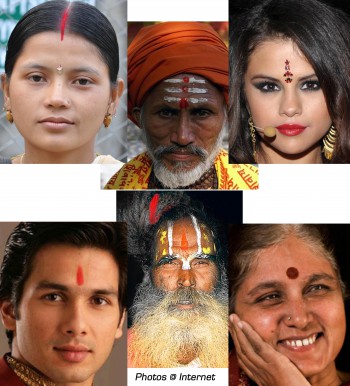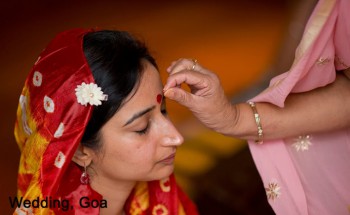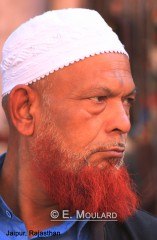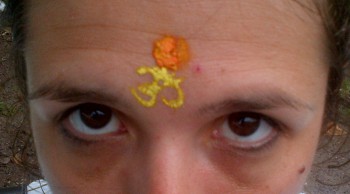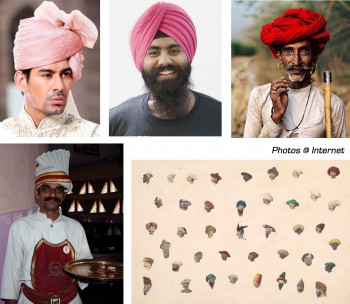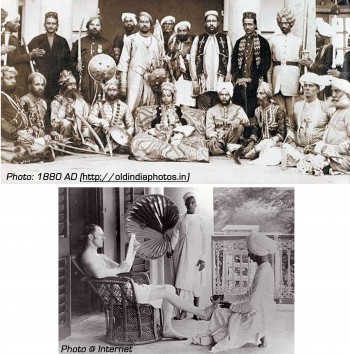10/26/2013
Why in India people burp when eating (or at any other point of time)
- Me: Hello, how are you today?
- My colleague: I’m not too good, I’ve got gas.
Oh Lord, gaaas??? How graceful! So for one thing my question was rhetorical and for another thing, gas??? Oh, this is gonna be a long, long day…
I wrote in August 2008 that while I "was peacefully walking in the street, a tiny old woman, passing by my side, let go of such a powerful burp that I would have been less shocked if she had called me a dirty bitch...".
Five years later, this topic is still big for me; for instance I recently had to inform one of my managers that if he wanted to promote one of his sales guys one day, he would have to start by asking him to stop burping all the time. This PIG makes me lose my appetite every time we eat together. He burps a good ten times during the meal. And not the small burps eh, no he goes all out, gives everything he has...
It is perhaps socially accepted (even appreciated) in India but when you work for an international company, you have to know the customs of your colleagues to avoid shocking your CEO visiting your country for a couple of days (and also losing all credit – yes I know, it’s sad but it is like this, we judge based on appearances...)
I am no one to give moral lessons to an Indian who would let out a huge fart in a train. But when my colleague blew my right ear with his burp, at a moment I was least expecting it (I was sitting in the car and on the phone), I forbade him very strongly to ever repeat this with me, ever again... So that we could share a good professional understanding. I do my best to adapt but I must admit, it is really hard when it comes to all these body noises...
It is actually probably the right thing to do and let the nature do, mind you but I just can't! Indians farts and burps a lot because 1. They don't restrain themselves, 2. They eat a lot of spicy food (which increases gases). Simple!
Here is what I had found on the burping theme at the time:
I asked myself “why am I such a prude?”, “why, even after 2 years, I still lose my appetite when an Indian guy burps loudly in the middle of a meal or why hearing someone clearing his throat in the restaurant sink gives me nausea? Why do I feel like slapping my Indian boss when he farts during a meeting?
appetite when an Indian guy burps loudly in the middle of a meal or why hearing someone clearing his throat in the restaurant sink gives me nausea? Why do I feel like slapping my Indian boss when he farts during a meeting?
Bah… I think that's CUL-TU-RAL... In Asia and the Middle East, a good eructation means that one has enjoyed the meal. In the Western world it is downright "yucky" (quote from the net which I fully support).
And yet, yet... These burping things have long been accepted in the West too.
For example, in the Roman empire:
"Burping at the table was a politeness justified by philosophers who thought that following the nature was the wisest thing to do." Pushing further this doctrine, the Emperor Claudius had taken an edict authorizing emitting other gaseous sounds. In his epigrams, Martial shows off to his hosts by calling with a snap of fingers the slave who brings them the urinal and helps them to use it. Finally, it was common to see, at the end of the cena, vomit soiling the precious mosaics of the floor. “ (1)
Then in the Middle-Age (2) (and you'll see that we are not far from the India of today!):
At the time, we ate very spicy food (and this causes gases (and Indians eat very spicy)); this was the era of spicy stews. (3)
Food is caught with the hands (which are regularly dipped in bowls of herbs to disinfect and perfume – fingerballs!). (4)
And people spat: "In the Middle Age, spitting was not only a custom, but also a natural need. The only restrictions that apply the courteous knights were to not spit on the table or across the table, but only under the table. » (5)
And finally at the Renaissance (I think this is the time burping started to become gross in Europe):
“Table manners appear in the nobility around 1530 following the publication of a book entitled Civilitas morum puerilium by Erasmus.” (6) Mundane meals became a sort of show where everyone shows off to be recognised for his rank. Catherine de Medici (1519-1589) brought the fork (with two teeth), fine earthenware and glassware, but we continued to eat with the fingers. At the table, the banks of the Middle-Age were replaced by individual seats, the towel became routine: it was very big to protect the flanges. On the tables, spices were easy to grab and they started serving meals with some order: it began with fruits, then gruels, the roasts or the grills, to finish by desserts. » (7)
Record:
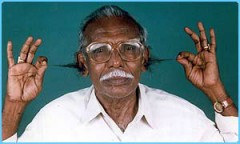 I did a small research and this is not an Indian who holds the record for the world loudest burp - they could, mind you, they already hold the record of longest hairs in the ears! (see post) - but a British, Hunnwhose burp reached 118.1 decibels (the equivalent of a chain saw in operation).
I did a small research and this is not an Indian who holds the record for the world loudest burp - they could, mind you, they already hold the record of longest hairs in the ears! (see post) - but a British, Hunnwhose burp reached 118.1 decibels (the equivalent of a chain saw in operation).
Quotes:
· "Why don't you burp or fart? Has this meal displeased you? “ Martin Luther.
· "Snobbery is a Champagne bubble that hesitates between fart and burp.” Serge Gainsbourg
· "Who does not burp nor fart is doomed to explode.": Erasmus.
(1) Source: emperors - Roman .net
(2) Article_Guidecasa.com_Le middle ages to table.pdf
(3) Source: guidecasa.com
(4) Source: peisme.blogspot.com
(5) Source: genebourgogne.org
(6) Source : Des bonnes manières.pdf
(7) Source : technoresto.org
(8) Source : Wikipedia
08:00 Posted in Why in India... | Permalink | Comments (0) | Tags: india, table manner, farting, burping, eructation, hair, hairs, hair in the ears, record, quotes | ![]() Facebook | |
Facebook | |
10/14/2013
Why in India people have red marks on the forehead?
Or, if we dig deeper, Who, when, how, where?
We can distinguish different ‘marks’: the dot in the middle forehead, the line at the root of the hair and the lines and other designs on the forehead. These marks are often red, but not always. It’s not easy to understand the whole thing!
So who wears what? Does a red dot mean a woman is married?
In North India, the red dot on the forehead would be traditionally the prerogative of married women. But not in South India. Anyway it has become a fashion element, which varies in shape, color and material (the sticker – top right photo – has been giving tough competition to the traditional bindi – bottom right).
It seems however that the sindoor applied at the root of the hair (top left) is only applied by married women (a way of saying don’t touch! – like others do with a ring!).
Men can also wear the tilak, for religious or aesthetic reasons.
In fact anyone (Hindu or not, man or woman, Indian or not) will bear a red mark on the forehead after attending a puja (religious ceremony): whether it's a small prayer at home or in the temple, it always ends by a marking on the forehead...
So... why?
Firstly for aesthetic reasons: Indians find it beautiful! Tastes and colors are not to be discussed...
Secondly the dot on the forehead is a Hindu religious symbol since the tilak, placed on the sixth chakra (‘agna’), represents the third eye or the eye of the mind, associated with deities and the concepts of meditation and spiritual enlightenment. It was originally exclusively for ‘knowledge holders’: idols, priests, ascetics. (1) The Vishnu worshippers’ tilak is a U of white color (obtained from sandalwood) drawn around a red or black line (bottom middle photo). And for Shivaites it is formed by three horizontal lines made from ashes (top middle). (2)
But above all there is a 'scientific' explanation: the body– the forehead and the point 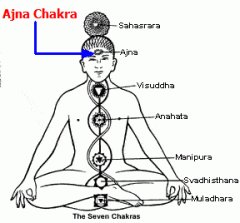 between the two eyes (seat of memory and thoughts) in particular – would produce energy in the form of electromagnetic waves. That’s how stress or anxiety creates heat and causes headaches. (1)
between the two eyes (seat of memory and thoughts) in particular – would produce energy in the form of electromagnetic waves. That’s how stress or anxiety creates heat and causes headaches. (1)
In Tantrism, during meditation, energy flows from the base to the head and leave the body by this point; hence the idea of "plugging the hole" to retain the energy inside. (3)
It is therefore to protect themselves and avoid energy losses that Hindus mark their forehead with a soothing and cooling powder paste.
Indeed, if the 'mark' varies in shape, colour, material and name ('tika', 'pottu', 'sindoor', 'tilak', 'tilakam', 'kumkum' and 'bindi', 'vermilion'), the traditional base (kumkum powder) is obtained by adding a few drop of lime to the yellow turmeric powder which then turns red (and add a little water to make it a paste). Some recipes contain saffron. And it turns out that both turmeric and saffron have medicinal properties as pain-killers! (4)
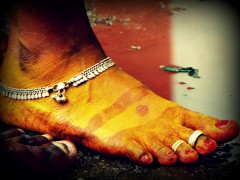 Turmeric is very present in the Indian culture. For example, in Andhra Pradesh, women used to apply it on (and under) the feet every day to protect them (because there were not too many shoes at the time (not that everyone wears shoes today either)). (5)
Turmeric is very present in the Indian culture. For example, in Andhra Pradesh, women used to apply it on (and under) the feet every day to protect them (because there were not too many shoes at the time (not that everyone wears shoes today either)). (5)
Indians may not have invented hot water* (not that they really need it anyways!) but their knowledge about medicinal plants is simply fascinating! Take henna. Not only is it cooling,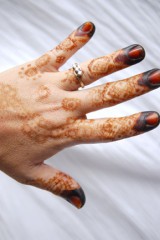 but also it is a coagulant for open wounds. Hence the tradition of Indian women to apply henna on their fingertips to protect themselves from the injuries inherent to manual chores. (6)
but also it is a coagulant for open wounds. Hence the tradition of Indian women to apply henna on their fingertips to protect themselves from the injuries inherent to manual chores. (6)
Here I owe an apology to my mother... After asking a thousand questions she came up with this one: “Tell me, why do these men have orange hair and beard?” I was a little bit upset with myself for not knowing the answer so I just told her whatever non-sense came to my mind: it is because they have used a bad quality dye which has faded!
In fact it seems that some men voluntary decide to have orange hair by dying it with henna. Apparently it could be because some Indians want to hide their gray hair but don’t have enough money to buy a good quality (black) dye. (7) The use of henna can also be linked to religion, as Islam would prohibit any dye except for henna. (8) When I asked my salesguy why do some people have orange hair he just told me that when people start to have gray hair they dye it, sometimes in black, sometimes in orange. No need to overthink it! You see Mum… ;)
* Sheer provocation?? Not only ! Apart from the zero, difficult to think of anything Indians actually invented… It doesn’t mean they are dumb though… They have stuff like the jugaad (in very short, “the gutsy art of overcoming harsh constraints by improvising an effective solution using limited resources”). Read more here.
(2) http://fr.wikipedia.org/wiki/Tilak
(3) http://hinduism.about.com/od/bindis/a/bindi.htm
(4) http://www.safrandugatinais.fr/en/vertus.htm; http://www.healthdiaries.com/eatthis/20-health-benefits-of-turmeric.html
(5) http://www.nandyala.org/mahanandi/?p=925
(6) http://www.ft.com/cms/s/0/d2933fb0-83de-11dc-a0a6-0000779fd2ac.html#ixzz2fW2qoFNh
(7) http://www.earthhenna.com/c158/c105/c98/The-Henna-Plant-c104.html
(8) http://ask.metafilter.com/88073/Why-would-a-Muslim-man-use-henna-to-dye-his-beard-orange
08:00 Posted in Why in India... | Permalink | Comments (0) | Tags: hair, hairs, beard, jugaad, innovation, orange, dye, henna, turmeric, saffron, spices, red dot, red mark, forehead, chakra, energy, meditation, third eye, tika, pottu, sindoor, tilak, tilakam, kumkum, bindi, agna, puja, kumkum powder, vermilion, orange hair | ![]() Facebook | |
Facebook | |
10/12/2013
Why in India some people don't cut their hair and wear a turban?
Sites dedicated to Sikhism explain that hair is a gift from God and therefore you don’t alter it (1). Moreover hair is beautiful (as any gift from God) then the longer the more beautiful.
That said, I am more and more convinced that any tradition or belief has a practical origin. As a matter of fact, if the Sikh religion appeared in 1469, emerging from the dominant religions (Hinduism and Islam), it is only in 1699 that cutting hair was forbidden (2). Now it so happens that at that time Sikhs were cornered: they had to give up non-violence (a founding principle of this religion) and take up arms against the Muslims who persecuted them (just as they were forcing Hindus to convert). As the Muslims wore beards – also certainly for practical reasons: “Act against the polytheists,” said Muhammad. “Carefully size your moustache and let yourself grow a beard.”(3) – and Hindus were moustachioed. To differentiate themselves (on the battle ground and otherwise) they had only two options left: leave it all or cut it all (but then it’s a lot of maintenance)...
And why the turban?
Long hair may be beautiful but it is not practical. Especially you are fighting and everything. Therefore, “the turban is in all respects a very convenient headgear; it is even more advantageous during war that our hats, because what they fall less easily, and can more easily prepare a blow of cutting edge”. (4) In addition it protects hair from the dust. And women can manage however they want (without a turban)...
But you must know that all turbaned men in India are not necessarily Sikh.
For example, the Rajasthani (top right) people, originally farmers and shepherds living in a mostly desert region, protect their head with a turban. Which varies in shape, size (even if it is usually 8-9 meter long (5)), material, colour and designs according to the wealth, caste and region of the wearer or the occasion.
Men wear turbans during weddings (top left).
And many janitors in big hotels or restaurants servers wear a turban (bottom left). In my opinion this practice dates from the colonial time when the Britishers must have found it classy to dress up their servants like that...
Morality, the turban does not (only) make the Sikh!
Subsidiary questions: How do Sikhs manage at the swimming pool with their turbans? How can Sikhs wear a helmet when on a bike? How do Sikhs pass airport security with their kirpan (dagger (2))?
At the pool, they take off their turbans but keep the piece of cloth th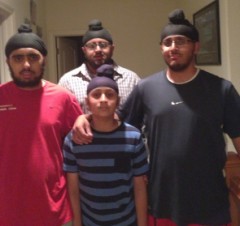 at covers their hair and makes them look like Smurfs and they avoid putting their head under water. Same thing when they play any sport.
at covers their hair and makes them look like Smurfs and they avoid putting their head under water. Same thing when they play any sport.
The regulation regarding helmet-wearing in India is a bit complicated, since it varies from one State to another. In Delhi for example, it is not compulsory for women to wear a helmet! And in Punjab and Haryana where there is a majority of Sikhs, wearing a helmet is simply optional. As a rule, Sikhs are not forced to wear helmets (which are too small to accommodate the turban!).
The Constitution of 1971 permits Sikhs to carry the kirpan in India. As for air-traveling, the kirpan is only allowed in a check-in luggage!
And why do all Sikhs bear the name Singh (men) and Kaur (women)?
Sikhism is an egalitarian religion, condemning discrimination based on gender or caste. Since in India, family names refer to caste, religion, region of origin, profession (yes all this! and it's hyper-complicated!), Sikhs use their ‘middle name’ as a surname. ‘Lion’ for men (Singh) and ‘Princess’ for women (Kaur).
But beware, the name Singh does not (only) make the Sikh.
There are people by the name Singh that are not Sikh. How to make things simple when they can be complicated? J
(1) http://www.realsikhism.com/index.php?subaction=showfull&id=1248365083&ucat=7
(2) Guru Gobind Singh (last of the 10 gurus who have developed the Sikh doctrine) has imposed the 5 kakas (5 K): hair and beard never cut (kesh) and retained by a comb (Adriana) symbolizing neatness, a metal bracelet (kara), military breeches (kachha) and a dagger (kirpan). Source: http://www.thecanadianencyclopedia.com/articles/fr/sikhisme; http://www.lemondedesreligions.fr/archives/2006/03/01/XVe-siecle-gourou-Nanak, 7928403.php
(3) http://www.slate.fr/lien/67915/barbe-moustache-monde-arabe
(4) http://alembert.fr/index.php?option=com_content & id = 640409723
(5) http://www.indianetzone.com/42/turbans.htm
Other sources: http://forums.Bharat-rakshak.com/viewtopic.php?p=600509 ; http://www.fashion.arts.AC.UK/media/research/documents/toolika-Gupta-effect-of-British-Raj-on-Indian-costume.PDF
08:00 Posted in Why in India... | Permalink | Comments (0) | Tags: india, hair, religion, sikh, turban, long hair, beard, moustache, turbaned, sikhism, islam, hinduism, guru, gobind singh, five kakas, kakas, rajasthani, name, singh kaur, warriors, kirpan, airport, motorcycle, helmet, sport | ![]() Facebook | |
Facebook | |















